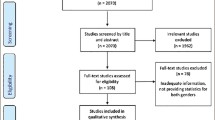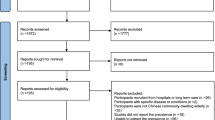Abstract
Objectives
Sarcopenia, an age-related decrease in muscle mass and function, is associated with several potential adverse health outcomes. Its association with another age-related syndrome, dysphagia remains unclear. This systematic review and meta-analysis aims to explore the association between sarcopenia and dysphagia.
Methods
PubMed, Embase, Scopus and CINAHL were searched for cross-sectional, case-control and cohort studies that investigated the association between sarcopenia and dysphagia. First author, publication year, study type, sample size, inclusion and exclusion criteria, participant demographics, definition and measurement for evaluation of sarcopenia and dysphagia, main outcomes were retrieved. The association between sarcopenia and dysphagia were expressed by odds ratio (OR) and 95% confidence interval (CI).
Results
9 studies are eligible in the systematic review, and 5 cross-sectional studies comprising 913 participants which showed dichotomous classification of sarcopenia and dysphagia were included in the meta-analysis. The crude odds ratios (ORs) were extracted from 5 studies, and 4 of them also provide adjusted ORs. The crude ORs between sarcopenia and dysphagia is 6.17 (95% CI, 3.81-10.00), after adjusting for some confounders, such as age, sex, Barthel Index score, nutritional status, sarcopenia is also have an association with dysphagia (adjusted ORs, 4.06; 95% CI, 2.27-7.29). The subgroup analysis showed that there was no significant difference between different sarcopenia diagnostic criteria, assessment tools of skeletal muscle mass and dysphagia.
Conclusion
Sarcopenia was positively associated with dysphagia. Prevention and screening of dysphagia is essential among sarcopenic old patients. The causal relationship requires more prospective cohort study for confirmation.






Similar content being viewed by others
References
Miller F P, Vandome A F, Mcbrewster J. Dysphagia[M]. 2010.
Nogueira D. Presbyphagia[M]// Swallowing–Physiology, Disorders, Diagnosis and Therapy. Springer India, 2015:189–218.
Morisaki N. Relationship between swallowing functions and health-related quality of life among community-dwelling dependent older individuals [J]. Japan Journal of Nursing Science Jjns, 2017.
Miura H, Hara S, Yamasaki K, et al. Relationship Between Chewing and Swallowing Functions and Health-Related Quality of Life[M]// Oral Health Care -Prosthodontics, Periodontology, Biology, Research and Systemic Conditions. InTech, 2012.
Miura H, Yamasaki K, Morizaki N, et al. Factors influencing oral health-related quality of life (OHRQoL) among the frail elderly residing in the community with their family[J]. Archives of Gerontology & Geriatrics, 2010, 51(3):e62–e65.
Maeda K, Akagi J. Sarcopenia is an independent risk factor of dysphagia in hospitalized older people [J]. Geriatrics & Gerontology International, 2015, 16(4):515–521.
Carrión S, Roca M, Costa A, et al. Nutritional status of older patients with oropharyngeal dysphagia in a chronic versus an acute clinical situation [J]. Clinical Nutrition, 2016.
Cruzjentoft A J, Baeyens J P, Bauer J M, et al. Sarcopenia: European consensus on definition and diagnosis: Report of the European Working Group on Sarcopenia in Older People.[J]. Age & Ageing, 2010, 39(4):412.
Rosenberg IH. Sarcopenia: Origins and clinical relevance. The Journal of Nutrition. 1997; 127:990–991
Vandewoude M F, Alish C J, Sauer A C, et al. Malnutrition-sarcopenia syndrome: is this the future of nutrition screening and assessment for older adults?[J]. Journal of Aging Research, 2012, 2012(7):651570.
Chang K V, Hsu T H, Wu W T, et al. Association Between Sarcopenia and Cognitive Impairment: A Systematic Review and Meta-Analysis[J]. Journal of the American Medical Directors Association, 2016, 17(12):1164.e7.
Sakai K, Sakuma K. Sarcopenic Dysphagia as a New Concept[M]// Frailty and Sarcopenia -Onset, Development and Clinical Challenges. 2017.
Chang S F, Lin P L. Systematic Literature Review and Meta-Analysis of the Association of Sarcopenia With Mortality.[J]. Worldviews on evidence-based nursing / Sigma Theta Tau International, Honor Society of Nursing, 2016, 13(2):153–162.
Janssen I, Heymsfield S B, Ross R. Low Relative Skeletal Muscle Mass (Sarcopenia) in Older Persons Is Associated with Functional Impairment and Physical Disability[J]. Journal of the American Geriatrics Society, 2002, 50(5):889–896.
Hou Y, Tian J, Zhang J, et al. Quality of meta-analysis in nursing fields: An exploration based on the JBI guidelines[J]. Plos One, 2017, 12(5):e0177648.
Moola S, Munn Z, Tufanaru C, Aromataris E, Sears K, Sfetcu R, Currie M, Qureshi R, Mattis P, Lisy K, Mu P-F. Chapter 7: Systematic reviews of etiology and risk. In: Aromataris E, Munn Z (Editors). Joanna Briggs Institute Reviewer’s Manual. The Joanna Briggs Institute, 2017. Available from https://reviewersmanual.joannabriggs.org/
Higgins J P, Thompson S G, Deeks J J, et al. Measuring inconsistency in metaanalyses.[J]. British Medical Journal, 2003, 327(7414):557–560.
Kojima G, Iliffe S, Jivraj S, et al. Association between frailty and quality of life among community-dwelling older people: a systematic review and meta-analysis[J]. J Epidemiol Community Health, 2016:jech-2015-206717.
Wakabayashi H, Takahashi R, Watanabe N, et al. Prevalence of sarcopenia and its association with dysphagia in cancer patients who require rehabilitation[J]. Journal of Rehabilitation Medicine, 2017.
Kohji M, Hirohiko H, Yutaka W, et al. Relationship between swallowing function and the skeletal muscle mass of older adults requiring long-term care[J]. Geriatrics & Gerontology International, 2015, 15(10):1185–1192.
Maeda K, Takaki M, Akagi J. Decreased Skeletal Muscle Mass and Risk Factors of Sarcopenic Dysphagia: A Prospective Observational Cohort Study[J]. Journals of Gerontology, 2016, 72(9).
Takagi D, Hirano H, Watanabe Y, et al. Relationship between skeletal muscle mass and swallowing function in patients with Alzheimer’s disease[J]. Geriatrics & Gerontology International, 2016, 17(3).
Yoshimura Y, Wakabayashi H, Bise T, et al. Prevalence of sarcopenia and its association with activities of daily living and dysphagia in convalescent rehabilitation ward inpatients[J]. Clinical Nutrition, 2017.
Shiozu H, Higashijima M, Koga T. Association of sarcopenia with swallowing problems, related to nutrition and activities of daily living of elderly individuals.[J]. Journal of Physical Therapy Science, 2015, 27(2):393.
Sagawa K, Kikutani T, Tamura F, et al. Factors related to skeletal muscle mass in the frail elderly[J]. Odontology, 2016:1–5.
Chen L K, Liu L K, Woo J, et al. Sarcopenia in Asia: consensus report of the Asian Working Group for Sarcopenia.[J]. Journal of the American Medical Directors Association, 2014, 15(2):95–101.
Veldee M S, Peth L D. Can protein-calorie malnutrition cause dysphagia?[J]. Dysphagia, 1992, 7(2):86.
Robbins J A, Levine R, Wood J, et al. Age Effects on Lingual Pressure Generation as a Risk Factor for Dysphagia[J]. Journals of Gerontology, 1995, 50(5):M257–62.
Robbins J A, Gangnon R E, Ms S M T, et al. The Effects of Lingual Exercise on Swallowing in Older Adults[J]. Journal of the American Geriatrics Society, 2005, 53(9):1483–1489.
Fisher A G, Seaborne R A, Hughes T M, et al. Transcriptomic and epigenetic regulation of disuse atrophy and the return to activity in skeletal muscle.[J]. Faseb Journal Official Publication of the Federation of American Societies for Experimental Biology, 2017.
Wakabayashi H, Matsushima M, Uwano R, et al. Skeletal muscle mass is associated with severe dysphagia in cancer patients[J]. Journal of Cachexia Sarcopenia & Muscle, 2015, 6(4):351.
Hathaway B, Vaezi A, Egloff A M, et al. Frailty measurements and dysphagia in the outpatient setting.[J]. Annals of Otology Rhinology & Laryngology, 2014, 123(9):629–35.
Hathaway B, Baumann B, Byers S, et al. Handgrip strength and dysphagia assessment following cardiac surgery[J]. Laryngoscope, 2015, 125(10):2330–2.
Gibson D J, Burden S T, Strauss B J, et al. The role of computed tomography in evaluating body composition and the influence of reduced muscle mass on clinical outcome in abdominal malignancy: a systematic review.[J]. European Journal of Clinical Nutrition, 2015:1079–1086.
Heymsfield S B, Wang Z, Visser M, et al. Techniques used in the measurement of body composition: an overview with emphasis on bioelectrical impedance analysis.[J]. American Journal of Clinical Nutrition, 1996, 64(3 Suppl):478S–484S.
Chang K V, Hsu T H, Wu W T, et al. Is sarcopenia associated with depression? A systematic review and meta-analysis of observational studies[J]. Age & Ageing, 2017:1.
Popman A, Richter M, Allen J, et al. High nutrition risk is associated with higher risk of dysphagia in advanced age adults newly admitted to hospital[J]. Nutrition & Dietetics, 2017.
Kim H M, Choi K H, Kim T W. Patients’ radiation dose during videofluoroscopic swallowing studies according to underlying characteristics[J]. Dysphagia, 2013, 28(2):153–158.
Etges C L, Scheeren B, Gomes E, et al. Screening tools for dysphagia: a systematic review[J]. Codas, 2014, 26(5):343.
Demir N, Arslan S S, Özgü Inal, et al. Reliability and Validity of the Turkish Eating Assessment Tool (T-EAT-10)[J]. Dysphagia, 2016, 31(5):1–6.
Crary M A, Mann GDGroher M E. Initial psychometric assessment of a functional oral intake scale for Dysphagia in stroke patients[J]. Archives of Physical Medicine & Rehabilitation, 2005, 86(8):1516–1520.
Maeda K, Koga T, Akagi J. Tentative nil per os leads to poor outcomes in older adults with aspiration pneumonia[J]. Clinical Nutrition, 2015, 35(5):1147–1152.
Wakabayashi H. Presbyphagia and Sarcopenic Dysphagia: Association between Aging, Sarcopenia, and Deglutition Disorders[J]. Journal of Frailty & Aging, 2014, 3(2):97.
Author information
Authors and Affiliations
Corresponding author
Rights and permissions
About this article
Cite this article
Zhao, WT., Yang, M., Wu, HM. et al. Systematic Review and Meta-Analysis of the Association Between Sarcopenia and Dysphagia. J Nutr Health Aging 22, 1003–1009 (2018). https://doi.org/10.1007/s12603-018-1055-z
Received:
Accepted:
Published:
Issue Date:
DOI: https://doi.org/10.1007/s12603-018-1055-z




